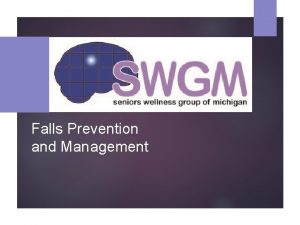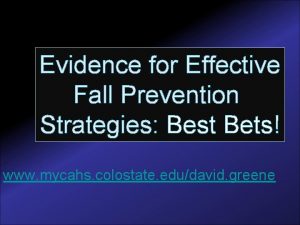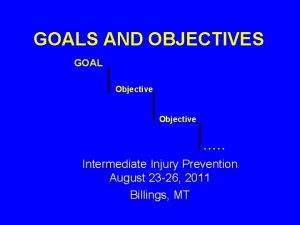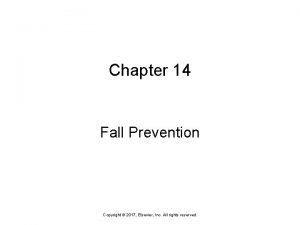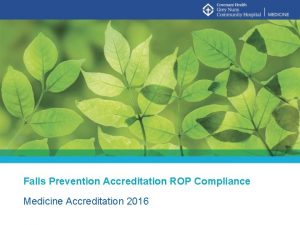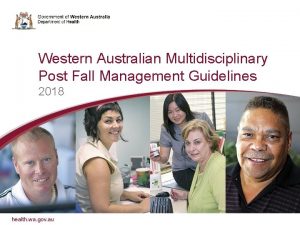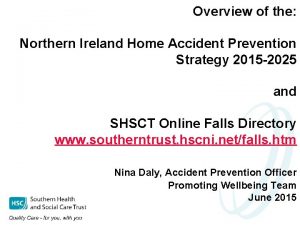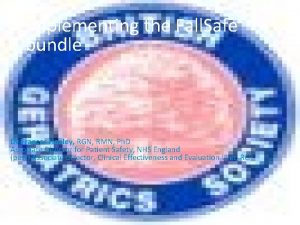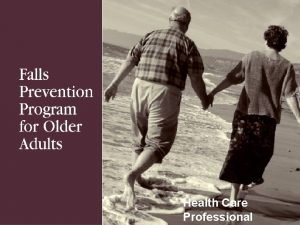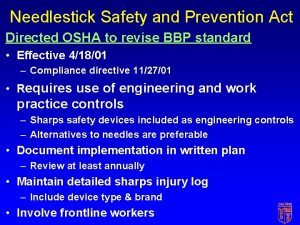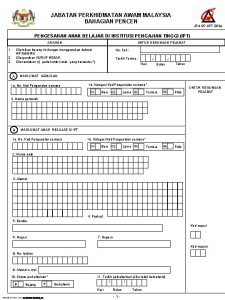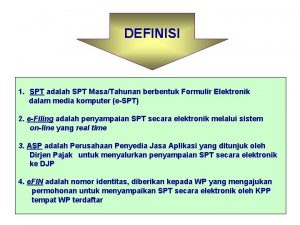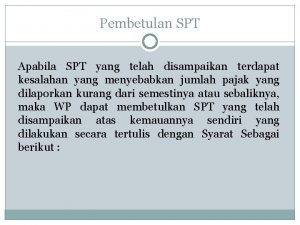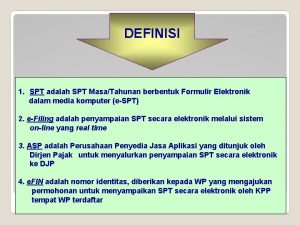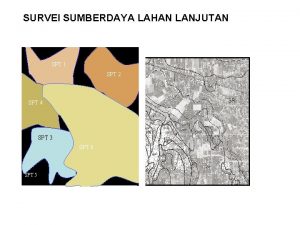FALL PREVENTION AND SAFETY EMILY FONTAINE SPT OVERVIEW















- Slides: 15

FALL PREVENTION AND SAFETY EMILY FONTAINE, SPT

OVERVIEW • • • The importance of fall prevention Assessing the risk of a patient Fall Precautions Safety with transfers Patient education

WHY FALL PREVENTION? • Falls are the leading cause of injury death in people 65 and older • Falls make up the largest category of reported incidents in hospitals • Patients who fall often sustain injuries that lead to hospitalizations

AN ACTIVITY • An activity before we begin: • Get a pair of glasses • Walk around with the glasses on • Trying going upstairs

ACTIVITIES CONT. Think about our patients who have physical weaknesses and balance problems on top of their bad eye sight. • It is incredibly easy to fall! • Their safety is extremely important

HOW TO ASSESS A PATIENT’S RISK • Morse Fall Scale (MFS) is used with all patients to assess fall risk • Nurses will perform this test, but the entire medical team will utilize it

MORSE FALL SCALE (MFS) United States Department of Veteran Affairs

DO THE MATH! • You are asked to complete the MFS for a new patient, Ted fell a week ago while in acute care at MGH. He uses a rolling walker because his strength is weak and is a moderate assist for walking. He doesn’t need an IV pole and has normal mental status what would his MFS number be? 50

RISK LEVEL WITH MORSE SCALE • No risk: 0 – 24 points • Low risk: 25 -50 points • High risk: 51 points or greater • Ted will be a low risk, but very close to high. This is a patient that will need to be monitored very closely during transfers and gait.

FALL PREVENTION STATUS • Low Fall Risk: 25 -50 on MFS • Assess the patient’s coordination and balance before transferring or mobilizing the patient • High Fall Risk: 50 or more on MFS • This will be made clear in the patient chart • Use bed alarms, bed rails, and a sitter if necessary so patient does not get out of bed without assistance • Make sure medications to decrease fall risks are taken on schedule

TRANSFERRING • Know the patient’s transfer status (independent, minimal assist etc. ) and fall risk • While transferring • • • Make sure the bed is lowered and locked Move any possible obstacles that are on the floor Have the patient wear shoes or treaded socks Block the patient’s knees if necessary Transfer patients towards their strong side Don’t allow patients to lean on moveable equipment • We will now demonstrate two transfers

AMBULATION • Know the risk of the patient • Use gait belts and assistive devices when necessary • Use the Berg Balance Scale • Assesses independence • See Physical Therapy Floor Manager for more details • We will now demonstrate how to utilize the gait belt Berg Balance Test

PATIENT EDUCATION • Do: • Wear appropriate footwear • Arrange furniture so you can walk easily • Install railings on the stairs and nonslip mat in shower • Use a night light • Don’t: • Walk and talk at the same time • Attempt a task that’s too difficult that will cause you to get tired while doing it • Walk in the dark

QUESTIONS?

WORKS CITED 1. 2. 3. 4. 5. Care Company Website. http: //dev. thecarecompany. biz/. Accessed October 20, 2012. “Fall Prevention. ” In Total Home Health. Accessed October 8, 2012, from http: //www. totalhomehealthinc. com/fall-prevention. htm. “Fall Prevention in Hospitals. ” Premier. Retrieved October 8, 2012, from https: //www. premierinc. com/safety/topics/falls. Pelczarski and Wallace. (October 15, 2009). “Hospitals Collaborate to Prevent Falls. ” In Patient Safety and Quality Healthcare (PSQH). Accessed October 8, 2012, from http: //www. psqh. com/novemberdecember-2008/91 -november-december 2008/277 -hospitals-collaborate-to-prevent-falls. html. “VA National Center for Patient Safety. ” United States Department of Veterans Affairs. Accessed October 8, 2012, from http: //www. patientsafety. gov/Cog. Aids/Fall. Prevention/index. html#page=pa ge-1
 Primary prevention secondary prevention tertiary prevention
Primary prevention secondary prevention tertiary prevention Fall prevention quiz for nurses
Fall prevention quiz for nurses L'eq
L'eq Examples of smart goals for fall prevention
Examples of smart goals for fall prevention Chapter 14 fall prevention
Chapter 14 fall prevention S-p-l-a-t-t fall prevention
S-p-l-a-t-t fall prevention Fall prevention interventions
Fall prevention interventions Mullinure hospital armagh
Mullinure hospital armagh Fall prevention interventions
Fall prevention interventions Fall prevention interventions
Fall prevention interventions Fall prevention occupational therapy
Fall prevention occupational therapy Injury prevention safety and first aid
Injury prevention safety and first aid Osha needlestick protocol
Osha needlestick protocol Test
Test How is potential energy measured
How is potential energy measured Jpa.bp.spt.b03a
Jpa.bp.spt.b03a

